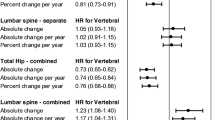Abstract
A history of fracture and a low bone mineral density (BMD) are the strongest predictors of future osteoporotic fracture. This prospective cohort study assessed the impact of these two factors on treatment patterns in women undergoing their first BMD testing in a non-academic community setting. Successive women seen for first BMD testing at two testing centers completed a baseline questionnaire and a mailed 3-month follow-up questionnaire. Patients were grouped by history of fracture after age 20 years (present, absent) and by BMD result [osteoporosis (OP), osteopenia (OPN), normal BMD]. Thirty percent of 1144 patients at least 45 years old reported a history of fracture after age 20 years. They were no more likely than those without a history of fracture to be taking calcium (52% of total), vitamin D (31%), estrogen (31%), or a bisphosphonate (2%) before BMD testing. The BMD testing revealed OP in 20%, OPN in 45%, and normal BMD in 35%. Three months later, the percentages of patients taking treatments differed as follows: calcium (66 vs 53% in OP and OPN groups vs normal BMD), vitamin D (46 vs 37% in OPN group vs normal BMD), estrogen (25 vs 36 vs 44% in groups with OP, OPN, and normal BMD), a bisphosphonate (43 vs 11 vs 1%), and at least one of estrogen or a bisphosphonate (58 vs 43 vs 46%). Treatment decisions were influenced by first BMD testing but not significantly by a history of fracture. There is a substantial care gap in the treatment of patients with OP: either bisphosphonate or estrogen therapy was taken by only 31% of patients at least 45 years old and with a history of fracture after age 20 years before BMD testing and by only 58% of these and who also had OP by BMD.

Similar content being viewed by others
References
Lindsay R, Silverman SL, Cooper C et al. (2001) Risk of new vertebral fracture in the year following a fracture. J Am Med Assoc 285:320–328
Ridout R, Hawker GA (2000) Use of bone densitometry by Ontario family physicians. Osteoporosis Int 11:393–399
Hajcsar EE, Hawker G, Bogoch ER (2000) Investigation and treatment of osteoporosis in patients with fragility fractures. Can Med Assoc J 163:819–822
McKercher HG, Crilly RG, Kloseck M (2000) Osteoporosis management in long-term care: survey of Ontario physicians. Can Family Phys 46:2228–2235
Fitt N, Mitchell S, Cranney A et al. (2001) Influence of bone densitometry results on the treatment of osteoporosis. Can Med Assoc J 164:777–781
Papa LJ, Weber BE (1997) Physician characteristics associated with the use of bone densitometry. J Gen Intern Med 12:781–783
Pressman A, Forsyth B, Ettinger B, Tosteson ANA (2001) Initiation of osteoporosis treatment after bone mineral density testing. Osteoporosis Int 12:337–342
Solomon DH, Levin E, Helfgott SM (2000) Patterns of medication use before and after bone densitometry: factors associated with appropriate treatment. J Rheumatol 27:1496–1500
Genant HK, Cooper C. Poor G et al. (1999) Interim report and recommendations of the World Health Organization task force on osteoporosis. Osteoporosis Int 10:259–264
Juby AG, Davis P (2001) A prospective evaluation of the awareness, knowledge, risk factors and current treatment of osteoporosis in a cohort of elderly subjects. Osteoporosis Int 12:617–622
Siris ES, Miller PD, Barrett-Connor E et al. (2001) Identification and fracture outcomes of undiagnosed low bone mineral density in postmenopausal women. Results from the National Osteoporosis Risk Assessment. J Am Med Assoc 286:2815–2822
Klotzbuecher CM, Ross PD, Landsman PB et al. (2000) Patients with prior fractures have an increased risk of future fractures: a summary of the literature and statistical synthesis. J Bone Miner Res 15:721–739
Castel H, Bonneh DY, Sheref M, Liel Y (2001) Awareness of osteoporosis and compliance with management guidelines in patients with newly diagnosed low-impact fractures. Osteoporosis Int 12:559–564
Silverman SL, Greenwald M, Klein RA, Drinkwater BL (1997) Effect of bone density information on decisions about hormone replacement therapy: a randomized trial. Obstet Gynecol 89:321–325
Rolnick SJ, Kopher R, Jackson J et al. (2001) What is the impact of osteoporosis education and bone mineral density testing for postmenopausal women in a managed care setting? Menopause 8:141–148
Rubin SM, Cummings SR (1992) Results of bone densitometry affect women’s decisions about taking measures to prevent fractures. Ann Intern Med 116:990–995
Jamal SA, Ridout R, Chase C et al. (1999) Bone mineral density testing and osteoporosis education improve lifestyle behaviors in premenopausal women: a prospective study. J Bone Miner Res 14:2143–2149
Sturtridge W, Lentle B, Hanley D (1996) Prevention and management of OP: consensus statements from the Scientific Advisory Board of the Osteoporosis Society of Canada. 2. The use of bone density measurement in the diagnosis and management of osteoporosis. Can Med Assoc J 155:924–929
Brown JP, Josse RG, The Scientific Advisory Council of the Osteoporosis Society of Canada (2002) 2002 clinical practice guidelines for the diagnosis and management of osteoporosis in Canada. Can Med Assoc J 167:1S–34S
Angbratt M, Moller M (1999) Questionnaire about calcium intake: Can we trust the answers? Osteoporosis Int 9:220–225
Acknowledgement. This study was supported by an unrestricted grant from Eli Lilly Canada, Inc.
Author information
Authors and Affiliations
Corresponding author
Rights and permissions
About this article
Cite this article
Hamel, M.E., Sebaldt, R.J., Siminoski, K. et al. Influence of fracture history and bone mineral density testing on the treatment of osteoporosis in two non-academic community centers. Osteoporos Int 16, 208–215 (2005). https://doi.org/10.1007/s00198-004-1776-1
Received:
Accepted:
Published:
Issue Date:
DOI: https://doi.org/10.1007/s00198-004-1776-1




